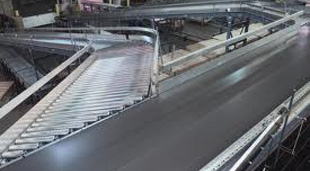From SCDigest's On-Target E-Magazine
Sept, 8 , 2011
Logistics News: Cliff Holste on the Keys to Sortation System Success in Distribution
Poor System Performance Almost Always the Result of Problems in the Concepting and Planning Stages, Holste Says
SCDigest Editorial Staff
Even as newer materials handling technologies in the distribution center, such as automated case picking (ACP) and robotics, steal a lot of the current spotlight, traditional automated carton sortation systems continue to be the bread and butter of much of the DC automated materials handling industry.
Sortation systems in general are integrated material handling systems that provide automation of order picking, order consolidation and often truck loading processes, the heart of which is a sorter that will divert cartons down different lanes after order picking depending on the customer or shipping mode for which it is bound. There are variations on this basic theme, such as diverts for value-added service processing and sortation systems for inbound receipts for palletizing, but these are by far the most common schemes for outbound diverts.
SCDigest Says: |
 |
| In situations where system performance is poor, it's generally due to insufficient overall system planning in the concepting and budgeting phase, which can then lead to overlooking important functions and requirements. |
|
What Do You Say?
|
|
|
|
This provides the ability to consolidate cartons from various areas going to a specific customer or mode on a given pallet or truck, and also supports the concept of batch picking, which often drives much of the sortation system ROI. In batch picking, an order picker selects cartons across multiple customers requiring that SKU during a given order release cycle or "wave," using the sorter and supporting conveyor systems to get each specific carton in the batch where it needs to go.
Batch picking greatly increases picking efficiency by reducing the travel time associated with "discrete" order picking, in which order pickers pick complete customer orders or at least part of each customer order independently.
SCDigest Materials Handling Editor Cliff Holste has more than 30 years experience with the design and implementation of automated sortation systems in distribution, and indeed was involved early on in the development of the first sortation systems in the 1970s.
In this conversation with SCDigest editor Dan Gilmore, Holste shares his thoughts on the keys to sortation system success.
Gilmore: What are some of the first things a company needs to consider if it decides it needs a sortation system in its DC?
Holste: I think there are a number of issues that need to be considered at the outset. For example:
• Is manual sorting (utilizing a recirculating conveyor loop) a possibility, or do capacity/operational requirements dictate automatic sortation?
The manual sorting option, of course, is only for low volume operations.
• If automation is required – are the cartons conveyable and do they already contain a unique bar code identifier?
• Do you have the internal resources to develop the plans and specifications and handle the purchasing and project management phase of the project, or will you need to obtain outside assistance?
• When you include the cost of the various subsystems that are required to feed and takeaway product to and from an automatic sorter, even the most basic entry level system will require an investment approaching $750,000 to a million dollars or more. Obviously, costs can increase from there. Have you developed a project budget, and understand how it is going to be cost justified?
• Determine basic system capacity requirements – what will the sorter need to handle and at what rate?
 Other things are important, such as determining an overall rough initial system layout, and beginning to think about changeover plans from the old system to the new one, but these things come after these basic questions are answered. Other things are important, such as determining an overall rough initial system layout, and beginning to think about changeover plans from the old system to the new one, but these things come after these basic questions are answered.
Gilmore: When you’ve seen companies struggle to get their sorting projects right, what are main reasons that the system fails to meet expectations?
Holste: In situations where system performance is poor, it’s generally due to insufficient overall system planning in the concepting and budgeting phase, which can then lead to overlooking important functions and requirements.
For instance, in an automated sorting system, having accurate and timely replenishment of inventory in active pick locations is critical to maintaining sorting system performance and customer service levels. If you don’t get that right, which is a process outside of the sortation system itself, sorter system performance will suffer or even be considered a failure.
Another example of poor planning might be in failing to appropriately design in after-sort handling and shipping capacity, which can then lead to excessive system backups and shutdowns.
Gilmore: Some companies worry that a sortation system won’t be flexible enough to meet future needs, as conditions change. What are the keys to designing a system that has enough flexibility?
Holste: There are several types of sorters available covering a wide range of incremental capacities.
Before selecting a sorter, determine what your current capacity requirements are, then add for growth. The sorter may run initially at a rate well below its maximum design speed and then be increased as throughput demands rise.
(Distribution/Materials Handling Story Continues Below) |